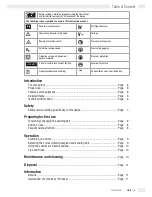
Safety / Preparing for first use
or grease.
J
Remain alert at all times! Always watch what
you are doing and proceed with caution. Do not
use the device if you cannot concentrate or you
are feeling unwell.
L
Preparing for first use
Take note of the mains voltage. The mains voltage
at the mains socket must match that shown on the
rating plate on the device.
Devices marked with 230 V can also be operated
at 220 V.
L
Tensioning / changing the sanding belt
m
Attention:
Before you carry out any work on
the belt sander always pull the plug out of the
mains socket.
1) Then release the tensioner for the sanding belt
by moving the tensioning lever
O
fully outwards
(see fig. A). The tensioner is now open and the
sanding belt can be removed.
2) Next insert a new sanding belt or change the
belt for one suitable for a different material or
one with a different grit size.
Important:
The direction of the arrows on the
inside of the sanding belt must agree with that
on sander housing.
3) Press the tensioning lever
O
back into its
initial position.
Adjusting the sanding belt
j
Pick up the device, switch it on and turn it over.
Adjust the belt tracking by turning the adjuster
screw
Y
until the edge of the sanding belt is
flush with and runs parallel to the edge of the
device (Fig. B.).
m
Attention:
Always make sure that the sanding
belt does not cut into the housing. Check the
sanding belt regularly and if necessary re-adjust
it using the adjuster screw
Y
.
L
Advice on use
Light sanding pressure is enough
j
Apply light sanding pressure only. The weight
of the belt sander alone is adequate to produce
good sanding results. By adopting this approach
you will also prolong the life of your sanding
belts and obtain a smoother workpiece surface.
Sanding and surfaces
The sanding output and the quality of the surface
finish obtained are determined by the belt speed
and the grade of grit on the sanding belt (see the
section on “Selecting the correct rotational speed
and sanding belt”). The following basic rule applies:
the higher the rotational speed / belt speed, the
higher the sanding output and the finer the sanded
surface finish.
Sanding procedure
With the sander switched on, bring it into contact
with the workpiece and move it forward carefully.
Work in parallel and overlapping widths. Always
work in the direction of the grain to avoid undesirable
transverse sanding marks.
j
The auxiliary handle
U
can be adjusted or
removed to allow you to sand difficult-to-
reach places.
L
Vacuum dust extraction
m
Warning! Danger of fire!
There is the danger
of fire when working with electrical devices that have
a dustbox or can be connected to a vacuum cleaner.
Under certain conditions the wood dust in the dust
collection box (or in the vacuum‘s dust bag) may
self-ignite, e.g. as a result of flying sparks generated
when abrading metals or metal objects left in wood.
This can happen particularly if the wood dust is
mixed with paint residue or other chemicals and the
abraded particles are hot from prolonged abrasion.
Therefore you must empty the device’s dust collec-
tion box and the vacuum cleaner’s dust bag before
taking a break or stopping work and always avoid
overheating of the abraded particles and the device.
8 GB/IE
Содержание KH 3172 BELT SANDER
Страница 1: ...Operation and Safety Notes Page 5 PEBS 900 Operation and Safety Notes...
Страница 10: ...12...




























